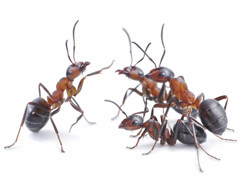Roles in ant societies
In ant societies, each ant has a specific role to play to contribute to the group's performance and ecological success. The project 'Behavioural syndromes, division of labour and communication of identity in complex insect societies' (IDENTITY CODE)(opens in new window) examined the individual differences among ants and the ways in which they communicate their identity. The division of labour among ants is primarily concerning two groups: the queen ants, responsible for reproduction, and the worker ants, which includes the majority of individuals in a colony. Ants communicate each other mainly through chemical cues. This project explored how chemical cues are used to communicate roles and identity within ant colonies. For example, researchers studied the behaviour and the chemistry of worker carpenter ants with an induced illness. They found that these ants behave more aggressively towards foreign ants than healthy individuals. On the other hand, they leave their own nest to avoid spreading the disease. In a different but comparable situation, researchers found that young queen leaf-cutter ants that have not been successful in mating and reproducing change their role and become workers. These two findings suggest that natural selection provides ants with adaptive behavioural flexibility. When researchers examined ants' communication mechanisms between the queen and the workers, they discovered the first queen pheromone regulating worker sterility. This was discovered in the black garden ant (Laisus niger) and it is a signal of the queen to inform the worker ants that she is fertile. Researchers were also able to unravel the mechanisms used by ants to communicate social identity. It appears that they do so by determining the similarity of their cuticular hydrocarbons and through learning and memory abilities. In addition, researchers found a link between sucrose responsiveness, learning success and task specialisation in ants. Taken together, the results provide new insights for better understanding the structure and communication of insect societies. They also contribute an improved understanding of the pivotal role of individual identity in social interactions.







